As local search and mobile users continues to grow, so does the importance of local SEO. In fact, 46% of searches on Google have local intent.
Aside from the sheer abundance of searchers, these local searches have been shown to be high-quality. According to Think With Google, 50% of users who conducted a local search on their smartphone visited a store within a day, and 34% who searched on a computer/tablet did the same.
As you can see, Local SEO is pretty important. Despite the clear importance, many businesses both large and small neglect it.
This guide will provide you the strategic approach you need to dominate in your backyard.
Goals
Before you can run any digital marketing campaign, you need to establish some goals. If not, how else will you know your efforts are successful?
Just as your business is unique, these goals should be as well. So ask yourself, what are you trying to improve locally?
- Web traffic
- Foot traffic
- Leads (phone calls, form submissions, etc.)
- Sales (both in-person and ecommerce, if applicable)
- Brand visibility
Now that we know the destination, let’s talk about how to get there.
Tactics
As local SEO continues to grow, so do tactics and strategies. Your approach will be similar to standard SEO, but with more of a focus on local.
Keyword Research
Anything you do that is SEO related should start with research. Without it, you’re basically throwing darts blindfolded.
When it comes to local, you need to adjust your keyword research slightly.
As opposed to just analyzing search queries based upon total monthly search volume and overall competitiveness, you’ll need to get a tad bit more granular.
For example, if you were crafting content around an upcoming yard/garage sale, many people would use a keyword analyzing tool, such as Google Trends, to see which variation of a word they should go with.

So, it’s settled. 'Garage sale' it is, right?
Eh, not so fast.
It depends on your target location.
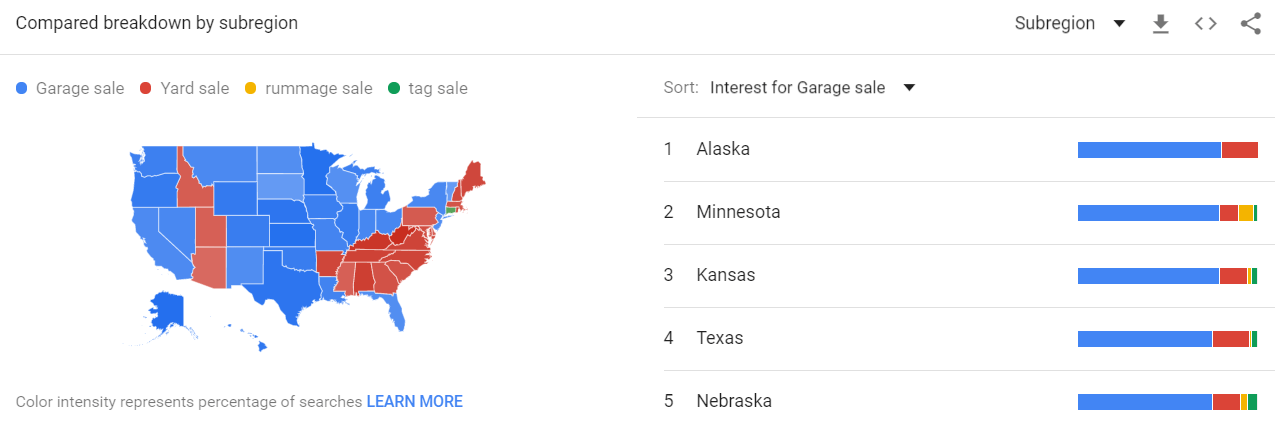
If you’re targeting Texas, then yes. But, if you’re located in Alabama, you’ll probably want to use yard sale. I say “probably” because for search terms with a large enough interest, you can analyze states by specific cities/regions. Seeing that garage/yard sales only really attract very local crowds, you should analyze the city you’re in.
For example, look at Pennsylvania. At first glance, assuming you’re not color blind, you’d think you should go with yard sale. However, if you live in Erie, you may want to go with garage sale.
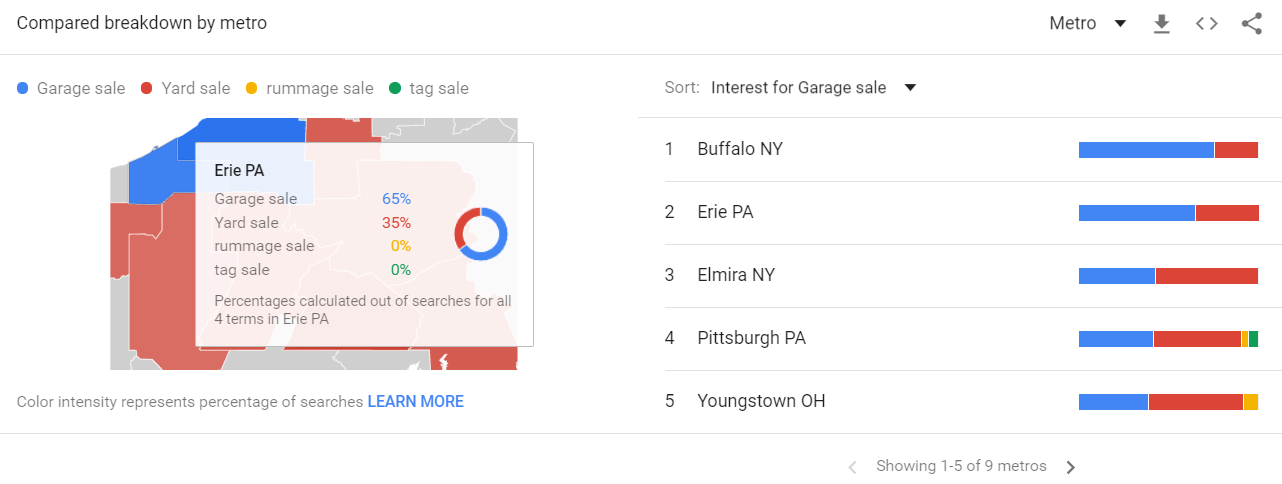
Note: If you’re from Connecticut and refer to it as a “tag sale” (whatever that is), you’re wrong.
Local Listing Optimization
Local listings such as Google My Business, Yelp, and Bing Place are essential for local SEO. They not only populate highly within search engine result pages (SERPS), but they also send signals to search engines to help better locate you.
The key to local listing optimization is to make sure of the following things:
- Ensure your name, address, and phone number (NAP) are accurate and consistent across them
- Fill out as many fields as you can
- Add a ton of relevant images
- Continue to manage and update them regularly
Localized on Site Optimization
Similar to the local listing components, when it comes to optimizing locally on your website, consistency is key. Be sure to have your NAP consistency throughout your website. Also, use location related keywords (such as your city or region) in your page titles, meta descriptions, and headers, when applicable.
Localized Content Creation
Develop content (both written and video) about stuff your community cares about or events happening in your community. Be sure to use location related keywords within your content, when it’s natural.
Local Link Building
Get links from reputable sources in the local community. This can also help you rank in an area you’re not physically located. White hat link building will improve your rankings and should also increase your referral traffic.
Get Involved/Sponsor
You can do all the marketing and advertising digitally you want, but if you’re not actually involved in the community, you won’t be as successful as you could be. Being involved or sponsoring other local organizations/events will help generate buzz in the local market.
This will help generate more mentions on local websites and social media accounts, drive more web traffic, and make people more receptible to linking to you.
Review Generation and Management
Reviews are not only a ranking factor, but they also greatly influence the probability of a user choosing your business among competitors. In fact, according to BrightLocal, 86% of consumers read reviews for local businesses (95% of people aged 18-34). And, according to Moz, 67% of consumers are influenced by online reviews.
Some reviews may lie, but numbers do not. Provide a great service and encourage users to leave a (hopefully) nice review. Also, be sure to respond to ALL of them (good and bad).
Metrics
So, you’ve done your research and you executed the plan flawlessly. Now, it’s time to check the metrics to see if the strategy is working and which, if any, adjustments need to be made.
Local Organic Traffic
If your goal was to increase organic traffic to your website, go into analytics, and look at organic traffic coming from the specific region you intended to improve. Set the time frame to the duration of your campaign thus far and compare that YOY. Hopefully, you should see an increase.
Below is a screen shot of one of our local SEO client’s organic traffic. As you can see, goal #1 was accomplished!
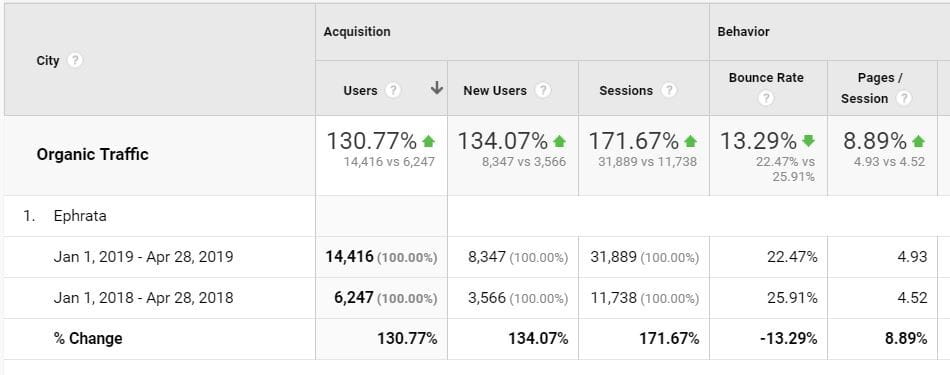
Organic Leads/Conversions
An increase in traffic is great and all, but it doesn’t paint the entire picture. How relevant was that traffic? Did your content simply rank well, or, did it move users to convert?
By analyzing your conversion metrics, you’ll be able to see how effective your actions were.
Below is an example of the same client’s conversion rates over that same period in the same location.
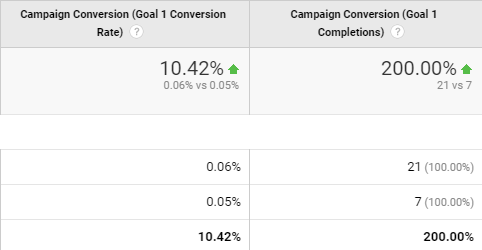
Goal number 2 – check
Referral Traffic and Links for Local Websites
In addition to organic traffic, take a look at referral traffic from local websites and compare that year over year.
Also, track how many new backlinks you’ve obtained. The more you get from reputable sources, the better.
Local Listing Data
Similar to analyzing conversions and leads via your website, many local platforms have their own analytics/reporting. One great platform to look at is the insights on Google My Business. Here, you can track your search visibility, popular queries used to find your business, customer actions (website visits, calls, and direction requests), and more.
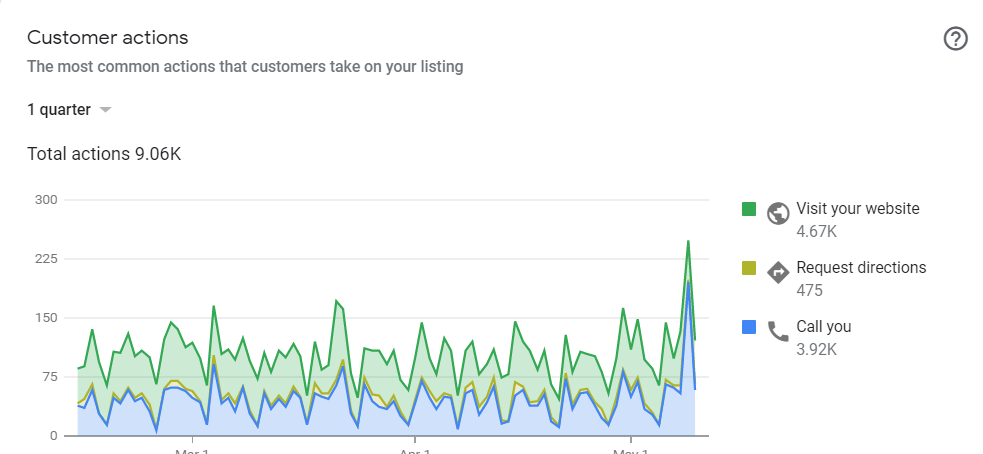
Above is a screenshot of the customer actions pulled from Google My Business. The more actions you’re seeing, the more quality users you are reaching.
Rankings for Local Related Keywords
While rankings aren’t everything, they are a good indication of improved visibility and the effectiveness of your optimizations. Analyze your rankings for search queries containing location related keywords and track your progress overtime. Ideally, both the totality of your rankings will increase, and your existing rankings will improve closer towards the top 1-3 positions in SERPs.
Backlinks/Mentions
Google uses brand signals as ranking factors. It speaks to your credibility. They gather these brand signals by analyzing a variety of factors including backlinks and unlinked brand mentions.
However, it’s not just about the totality of them, but more the quality. It can be difficult to determine which sources are considered high-quality but use your best judgement.
Start Dominating the Local Market
Looking to improve your positioning in the local market? Contact our team of experts today!

